Sleep
links: reference:
- https://en.wikipedia.org/wiki/Ultradian_rhythm
- Neurotransmitter system and neural circuits governing sleep
- https://supermemo.guru/wiki/NREM_and_REM_sleep 4-11-2021
Sleep #
- Vegan says Agomelatine and the like does not negatively affect REM while enhancing slow wave sleep, unlike Ethanol and GHB - which you can hardly call sleep. Meanwhile, Galantamine increases REM and noe at the expense of slow wave sleep. What’s there to lose??
- Well, it does decrease deep sleep in proportion to the increased REM, as well as efficiency and total sleep being decreased: The effects of galantamine and buspirone on sleep structure: Implications for understanding sleep abnormalities in major depression
- Major depressive disorder, sleep EEG and agomelatine: an open-label study in patients with MDD, it didn’t change REM latency, length, or density.
-
Matthew Walker’s “Why We Sleep” Is Riddled with Scientific and Factual Errors
- Mostly covers various statistical errors, namely association with cancer, etc..
- Is Matthew Walker’s “Why We Sleep” Riddled with Scientific and Factual Errors?
- “Why We Sleep — a tale of institutional failure” & “Why we sleep” data manipulation: A smoking gun? a lot of statistical misconduct.
- [Effects of thermal environment on sleep and circadian rhythmEffects of thermal environment on sleep and circadian rhythm]
- Heat exposure increases wakefulness and decreases slow wave sleep and rapid eye movement sleep.
- In animal studies, the thermoregulatory system is abolished during REM.
- Due to a loss of thermosensitivity in the majority of the hypothalamic preoptic neurons.
- In humans, thermosensitivity during REM is not completely depressed; however, sensitivity to hot or cold stimulation is reduced in REM compared to non-REM and wakefulness*
- The sweat rate increases during SWS compared to other sleep stages, while delayed onset of sweating and a decreased sweat rate decrease evaporative heat dissipation and reduce heat tolerance during REM
- Considering that skin sympathetic nerve activity (SSNA) contains sudomotor activity synchronous with vasodilator activity, this result indicates that SSNA might precede the sleep stage shift corresponding with heart rate variability (HRV) preceding the sleep stage shift at the sleep onset period
- In cold exposure, shivering during sleep is confined to stages 1 and 2 and is not observed in SWS and REM.
-
Timing of REM Sleep is Coupled to the Circadian Rhythm of Body Temperature in Man
- The peak in REM sleep propensity (RSP) occurred on the rising slope of the average body temperature curve (so 4AM onward?)
-
Structural differences between REM and non-REM dream reports assessed by graph analysis
- REM reports are typically rated as more intense, bizarre, perceptually vivid, emotional and kinesthetically engaging than non-REM reports, which are typically more thought-like and conceptual
-
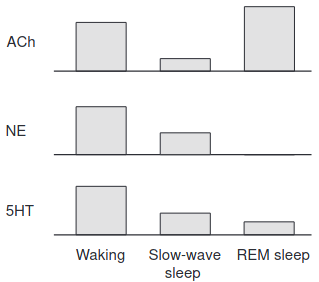
Architecture #
There is REM and 3 stages of NREM.
This is roughly what a single sleep cycle (the first of the night) can look like. It takes 90 +- 20 minutes.
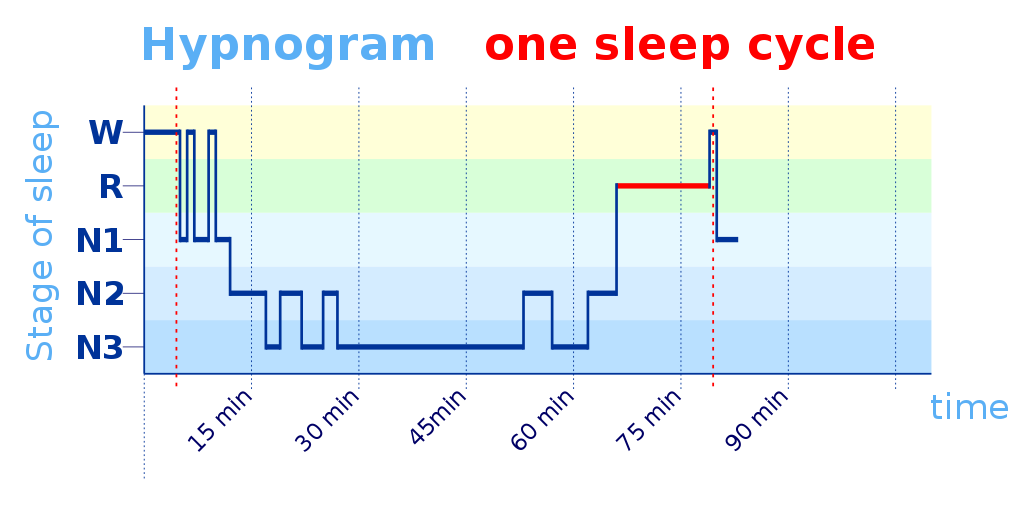 This is a pretty common representation of the sleep cycles through the whole night:
This is a pretty common representation of the sleep cycles through the whole night:
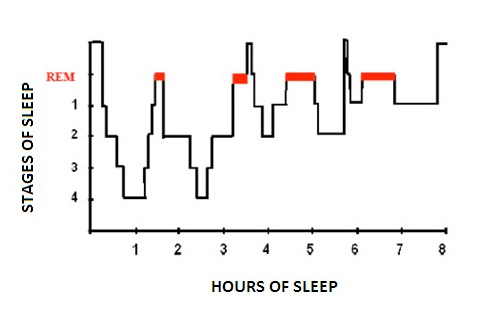 So there are 4-5 cycles a night. REM gets longer, with less deep sleep as the night goes on.
So there are 4-5 cycles a night. REM gets longer, with less deep sleep as the night goes on.
-
Modeling Napping, Post-Lunch Dip, and Other Variations in Human Sleep Propensity
- Major nighttime peak in SP, a post-noon peak and an associated secondary local minimum in early evening:
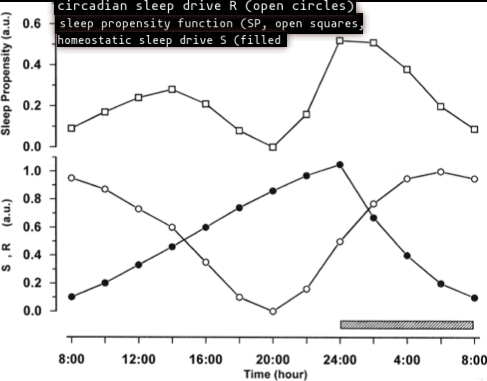
- Major nighttime peak in SP, a post-noon peak and an associated secondary local minimum in early evening:
Chronotype #
- The overlapping geography of cognitive ability and chronotype
- https://raypeatforum.com/community/threads/no-such-thing-as-chronotypes.29439/post-438537
-
Light as a modulator of emotion and cognition: Lessons learned from studying a diurnal rodent
- The change in daylight intensity over the seasons is a more salient factor than daylight duration for driving seasonality in modern humans
Science of sleep - SuperMemo #
- Printable version: Good sleep, good learning, good life
-
Timing of brainwork
-
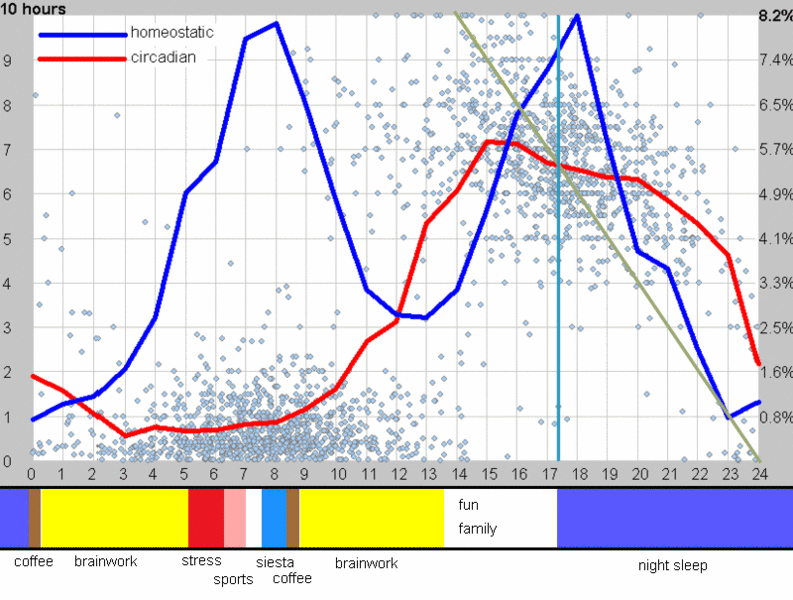
- Homeostaic sleep propensity: sleep drive determined by waking duration and physical/mental exertion. As you can see, maximum alertness is when homeostasic and circadian are the lowest. Why sports right before siesta? DYEL? But clearly I’ve chosen wisely working out at ~10-11 hours after waking, since that’s a decent figure. Coffee after a 4pm siesta is interesting, though.
- Exercise can temporarily reduce homeostatic sleepiness. Two components of sleep.
- Circadian sleep propensity = ability to maintain sleep. Homeostatic sleep propensity = ability to initiate sleep.
-
-
Baby Sleep
- Circardian and homeostatic rhythms are both mostly unchangeable, besides phase shifts and phase delays, but it’ll return to equilibrium eventually.
- It takes 1-2 months for a -
 baby to align to a rudimentary circadian pattern. Tl;dr: let babies sleep and feed on demand.
baby to align to a rudimentary circadian pattern. Tl;dr: let babies sleep and feed on demand. - Babies spend ~50% of time sleeping in REM; adults spend ~20%.
-
Factors that affect sleep
- There is no best time to exercise; this site pretty much aligns with my view.
- Sleep isn’t for muscle recovery. There’s no need to shut down the CNS for that.
- Zeitgeber is a signal affecting the sleep phase in the circadian cycle, e.g. sunlight.
- Reverse information flow in REM and NREM?
- Caffeine intake (200 mg) in the morning affects human sleep and EEG power spectra at night (it’s over)
- Learning increases heomeostatic drive, and may increase the density of REM, but doesn’t seem to increase total time spent sleeping. Sleep and learning
-
Sleep: myths and facts
- It should take as much time to wake up as it takes to fall asleep, i.e. 3-5 minutes. This is interesting and makes sense at first glance.
- Sleep isn’t for rest, but for optimizing memories. The metabolic rate drops only by 15% in sleep. And as claimed earlier, there’s no need to shut down the CNS for muscle recovery.
- (Supermemo - Neural optimization in sleep) talks about ACh
How do we fall asleep? #
- The suprachiasmatic nucleus is the main source of the circadian rhythm. It sends most of its fibers to the subparaventricular zone and the dorsomedial hypothalamic nucleus. I believe it’s the SCN first that prompts the activation of the pineal gland.
- The anterior hypothalamus is the presumed site where circadian input and the homeostatic signal are integrated, those being from the medial peroptic area, anterior paraventricular thalamic nucleus, and the dorsomedial hypothalmic nucleus.
- REM rebound hypothesis:
Naps #
-
Siesta 7-8 hours after waking (i.e 9am -> 4/5pm.)
-
Caffeine before napping undermines the benefits, but after may boost it.
-
Habitual napping improves quality over the years.
-
- Napping favors the Natural Creativity Cycle
- The correlation between properly-timed siesta and night (slow-wave) sleep yields something like 3:1 compensation.
-
- Timing in accordance to the circadian rhythm is essential, rendering polyphasic sleep a meme.
- Napping pre-siesta is likely to be short and much more rich in REM.
-
- Siestas are rich in NREM and increase altertness significantly. Improves recall and memory consolidation. Reduces blood pressure. Just don’t do it in poor conditions.
- Don’t use an alarm clock?? Well-scheduled won’t lead to sleep inertia unless sleep deprived. Do I believe this?
- Main meal of the day should come before the nap.
Biphasic Life #
Yo… the biphasic sleep pill… we’re back. Do you start sleeping 7-8 hours or is that how long you should sleep??
-
Polyphasic Geniuses
- Wozniak deboonks basically all the popular claims like Da Vinci, Edison, and Tesla. It’s true that rather than sleeping polyphasic proper, they probably just slept less than the average person and did so biphasically.
Sleep Deprivation #
- Deprivation lowers Leptin and increases Ghrelin. Narcoleptics are shown to have reduced leptin concentration, and insomniacs have lower ghrelin levels.
- This is the opposite of what happens during sleep, where leptin increases and ghrelin decreases.
- This is basically why people working night shift (or insomniacs) crave junk food and then store it as fat, since the lack of leptin makes you think there is a food shortage.
Adrenaline #
- Deep, restful sleep keeps Temperature somewhat low, while poor sleep (with high stress hormones) can cause waking temp to be high.
- During sleep, the HPA axis releases Cortisol to maintain Blood Glucose. If cortisol fails to be released for whatever reason, Adrenaline will do it. Adrenaline+cortisol begin to rise almost as soon as one goes to bed. Cortisol peaks at dawn, adrenaline in the afternoon.

Tips n’ Tricks #
-
https://www.youtube.com/watch?v=Hr79eQiTdmk
- Sleep at the same time every night. KEY.
- Exposure yourself to lots of sunlight upon waking.
- Make the room dark as possible.
- Eat lots of salt. It helps to retain magnesium and turn down aldosterone.
- Zinc, copper, vitamin C.
- Lower protein at last meal of day.
- Manganese in the afternoon might help with a slump?
- High fat intake before bed can exacerbate insomnia
- High Carbohydrate meals 2 hours before bed can promote sleep, but not 1 hour. R
-
https://archive.is/RWUD5
- This covers absolutely everything honestly. Glad I know 95% of this already.
- Side sleeping can promote carpal tunnel. I am just now realizing this.
- Stop eating 3-4 hours before bed.
- Goes into some devices, as well. Wearables,
- Optimal room temperature is something like 19-21°C (66.2-70°F). Matthew Walker recommends 63-66°F.
- Bryan Johnson’s routine:
https://www.bryanjohnson.co/articles/sleep-is-the-new-coffee
- Deep-wave sound machine
- Bryan Johnson:
https://medium.com/future-literacy/sleep-and-impulse-control-87e844218ff2
- 67°F room and electric blanket at 69.8°F.
- No alarms. I think this is obviously an excellent idea. With regards to medtation, maybe wake up hours before work (ideally have no work of course ;-) ) and make the difference with a longer meditation at night if you end up sleeping in too much that your schedule doesn’t have any slack (i.e. study/leisure period or what have you)
- Light-based alarm clock: ideally every night I press a button saying I’m about to fall asleep, which sets the alarm for to kick on after ~8h30m, and then it takes ~45 minutes from somewhat dim to full blast in my eyeballs.
- And if I don’t press the button, then it’ll just default to some average, ideal time. Chances are that’s early, since I was probably so tired I forgot to press it
- (Or, I sleep for 7.5 hours instead of 9. I wonder if if can be bad for me? There’s also meditation replacing some aspects of sleep, which may or may not be woo-woo)
- ~$50 Philips HF3520 (3510 is inferior): Colored dawn simulation of 20-40 minutes. 300 lux.
- Is that fuck all? According to some online calculator, 1600 lux at 45° and 3" = 3500. The other ones only reach 310.
- Also has like a sunset timer thing you can set
- Wearing (only) socks/gloves, keeping the extremities warm, actually decreases body temperature, since that’s the priority for the body, and you have it covered there.
Tech #
- Zeo is an EEG sleep tracker Gwern uses. It’s like $50 or $60. If the Muse S doesn’t work, then hello.
- Has an alarm clock built-in. I hope others have this too, since it’d be genius to wake you up at an optimal time with respect to your current cycle.
- The Hypnodyne ZMax seems to have a lot of clout http://www.hypnodynecorp.com/howtowear.php
- Bryan Johnson uses:
- Temperature-controlled mattress that automatically adjusts to the optimum temp for each sleep stage.
- Uses Whoop to track it
- Their sleep scores are simply based on duration vs. calculated need based on physical activity throughout the day + sleep debt, and I think having HRV in a certain green zone as well.
- For example Bryan gets somewhere between 8-9 hours (usually 9) (just above 7 and just under 10 a few times a month) and the sleep needed is usually calculated at like 7:40; thus always above it. https://twitter.com/bryan_johnson/status/1682495261057376256/photo/1 shit ain’t easy though, apparently.
- He’s in bed from 9-7 lol. NEET level schedule
- Their sleep scores are simply based on duration vs. calculated need based on physical activity throughout the day + sleep debt, and I think having HRV in a certain green zone as well.
- Doesn’t eat for 10 hours before sleeping
- Uses a pillow with neck indentation to prevent the jugular vein stenosis (medium-sized, stacked on a really thin one).
- Copper-infused pillow
- Pulsetto for falling back to sleep. Strengthening his pelvic floor with this vibration machine thing he sits on reduced awakenings to pee from 1 to 0, and also improved erections
- Just walks in and falls asleep in 4 minutes on average.
- Loftie lamp for sunrise alarm. Also has reading mode and whatnot
- Holy shit, apple watch SE if the best of all things? <$200 too. This is from The Quantified Scientist:
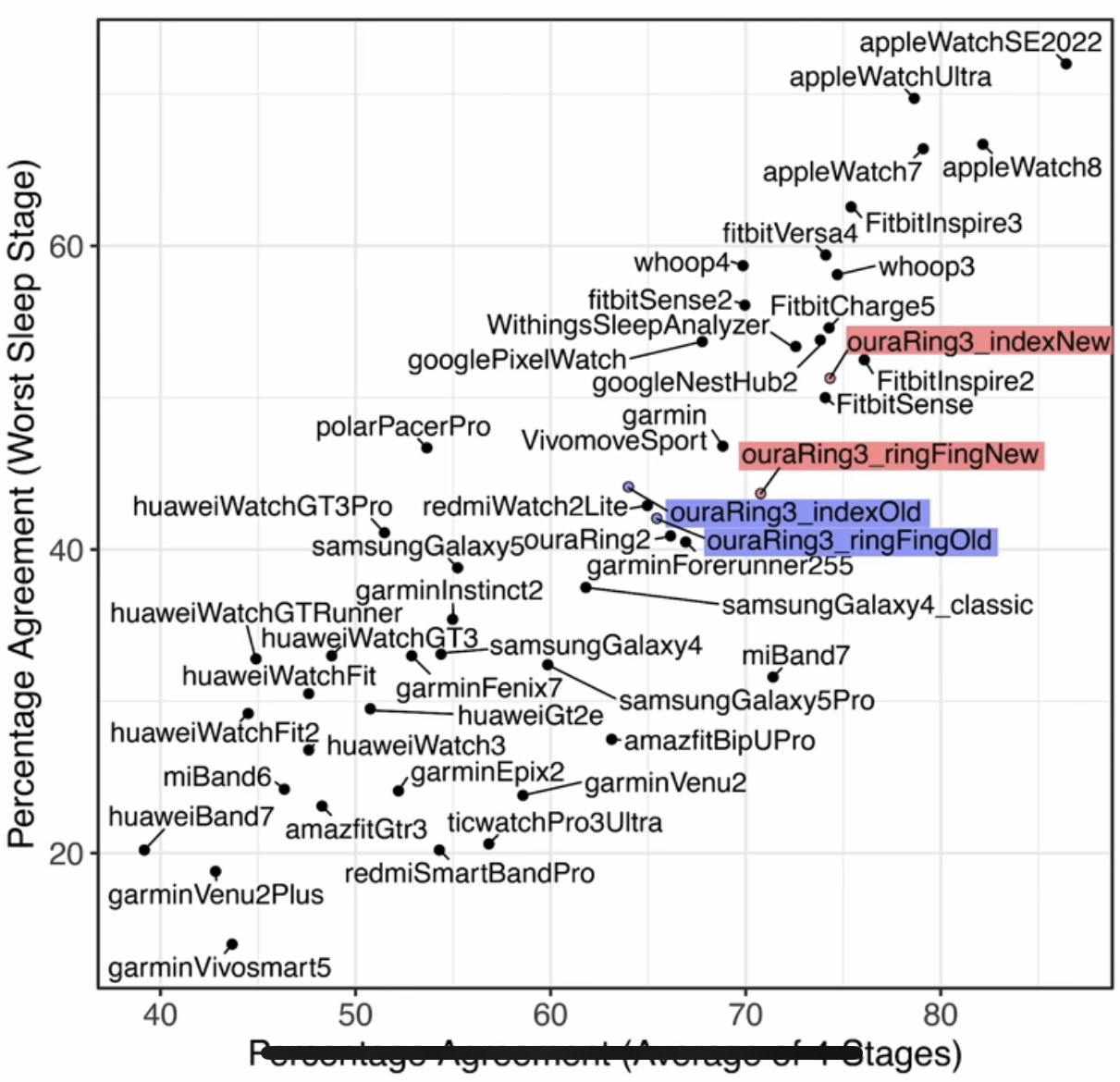
- https://old.reddit.com/r/apple/comments/xbhxho/the_apple_watch_seems_to_have_the_best/
- Fitbit Inspire 3 is like $100. Versa 4 also like $60 for just the ‘pebble’ if you buy another strap for what, $10?
- Dreem2 is the ultimate but that’s something you put on your head. $500 and idk if it’s for sale anymore. Looks comfy though and probably works just fine with headphones. It’s not publicly available since it’s FDA-approved or something, but I still think people are trying to source it. Few hundred on ebay every now and then.
- Compared to whoop 4: Whoop Strap 4.0: Long-term Scientific Review the deep sleep detection ir really good. But light and REM kind of suck - 60% prediction compared to the dreem 2. It’s still amongst the best, besides the watches.
- Wtf? The Dreem Headband compared to polysomnography for electroencephalographic signal acquisition and sleep staging it’s basically as good as polysomnography. You read ‘83.5 ± 6.4%’ and think that means compared to some objective rating, except PSG got 86.4 ± 7.4.